英语人教版八年级下册标题设计
(完整版)英语人教版八年级下册英语教学设计
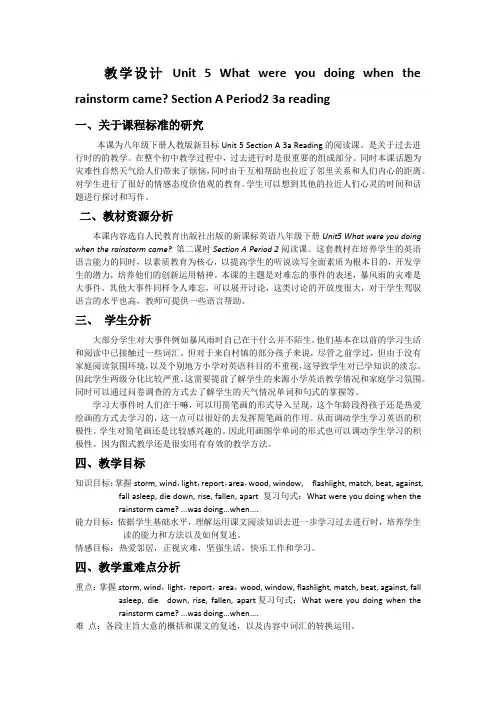
教学设计Unit 5 What were you doing when the rainstorm came? Section A Period2 3a reading一、关于课程标准的研究本课为八年级下册人教版新目标Unit 5 Section A 3a Reading的阅读课。
是关于过去进行时的的教学。
在整个初中教学过程中,过去进行时是很重要的组成部分。
同时本课话题为灾难性自然天气给人们带来了烦恼,同时由于互相帮助也拉近了邻里关系和人们内心的距离。
对学生进行了很好的情感态度价值观的教育。
学生可以想到其他的拉近人们心灵的时间和话题进行探讨和写作。
二、教材资源分析本课内容选自人民教育出版社出版的新课标英语八年级下册Unit5 What were you doing when the rainstorm came?第二课时Section A Period 2阅读课。
这套教材在培养学生的英语语言能力的同时,以素质教育为核心,以提高学生的听说读写全面素质为根本目的,开发学生的潜力,培养他们的创新运用精神。
本课的主题是对难忘的事件的表述,暴风雨的灾难是大事件,其他大事件同样令人难忘,可以展开讨论,这类讨论的开放度很大,对于学生驾驭语言的水平也高,教师可提供一些语言帮助。
三、学生分析大部分学生对大事件例如暴风雨时自己在干什么并不陌生,他们基本在以前的学习生活和阅读中已接触过一些词汇。
但对于来自村镇的部分孩子来说,尽管之前学过,但由于没有家庭阅读氛围环境,以及个别地方小学对英语科目的不重视,这导致学生对已学知识的淡忘。
因此学生两级分化比较严重。
这需要提前了解学生的来源小学英语教学情况和家庭学习氛围。
同时可以通过问卷调查的方式去了解学生的天气情况单词和句式的掌握等。
学习大事件时人们在干嘛,可以用简笔画的形式导入呈现,这个年龄段得孩子还是热爱绘画的方式去学习的,这一点可以很好的去发挥简笔画的作用。
从而调动学生学习英语的积极性。
新版人教版八年级英语下册全册教案(K12教育文档)
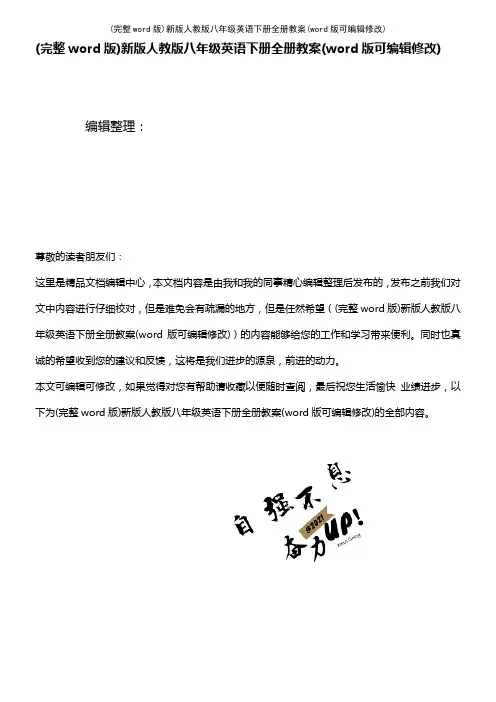
(完整word版)新版人教版八年级英语下册全册教案(word版可编辑修改) 编辑整理:尊敬的读者朋友们:这里是精品文档编辑中心,本文档内容是由我和我的同事精心编辑整理后发布的,发布之前我们对文中内容进行仔细校对,但是难免会有疏漏的地方,但是任然希望((完整word版)新版人教版八年级英语下册全册教案(word版可编辑修改))的内容能够给您的工作和学习带来便利。
同时也真诚的希望收到您的建议和反馈,这将是我们进步的源泉,前进的动力。
本文可编辑可修改,如果觉得对您有帮助请收藏以便随时查阅,最后祝您生活愉快业绩进步,以下为(完整word版)新版人教版八年级英语下册全册教案(word版可编辑修改)的全部内容。
新版人教版八年级英语下册全册教案Unit 1 What's the matter?教学目标:1语言目标:描述健康问题的词汇,及如何根据别人的健康问题提建议。
2 技能目标:能听懂谈论健康问题的对话材料;能根据别人的健康问题提建议;能写出重点单词和重点句型,并能描述怎样对待健康问题。
3 情感目标:通过开展扮演病人等活动,培养学生关心他人身体健康的品质.通过本课的阅读,培养学生处理紧急事件的基本能力,树立紧急事件时互相帮助的精神。
教学重点:短语:have a stomachache,have a cold,lie down,take one’s temperature,go to a doctor, get off,to one’s surprise, agree to do sth。
, get into trouble,fall down, be used to, run out (of), cut off , get out of, be in control of ,keep on (doing sth.), give up句子: 1 What’s the matter?I have a stomachache. You shouldn’t eat so much next time.2 What’s the matter with Ben?He hurt himself。
八年级下册人教版英语教学设计范文
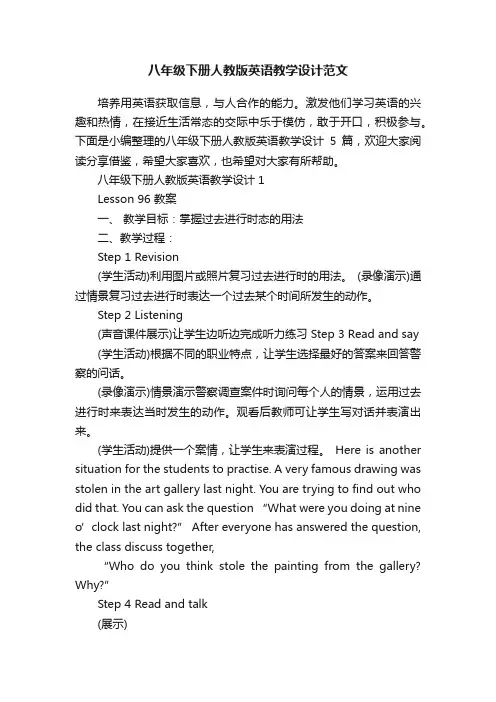
八年级下册人教版英语教学设计范文培养用英语获取信息,与人合作的能力。
激发他们学习英语的兴趣和热情,在接近生活常态的交际中乐于模仿,敢于开口,积极参与。
下面是小编整理的八年级下册人教版英语教学设计5篇,欢迎大家阅读分享借鉴,希望大家喜欢,也希望对大家有所帮助。
八年级下册人教版英语教学设计1Lesson 96 教案一、教学目标:掌握过去进行时态的用法二、教学过程:Step 1 Revision(学生活动)利用图片或照片复习过去进行时的用法。
(录像演示)通过情景复习过去进行时表达一个过去某个时间所发生的动作。
Step 2 Listening(声音课件展示)让学生边听边完成听力练习 Step 3 Read and say (学生活动)根据不同的职业特点,让学生选择最好的答案来回答警察的问话。
(录像演示)情景演示警察调查案件时询问每个人的情景,运用过去进行时来表达当时发生的动作。
观看后教师可让学生写对话并表演出来。
(学生活动)提供一个案情,让学生来表演过程。
Here is another situation for the students to practise. A very famous drawing was stolen in the art gallery last night. You are trying to find out who did that. You can ask the question “What were you doing at nine o’clock last night?” After everyo ne has answered the question, the class discuss together,“Who do you think stole the painting from the gallery? Why?”Step 4 Read and talk(展示)Read the table about what David was doing at different times yesterday, then ask and answer in pairs.(录像演示)情景演示询问过去某个时间点正在进行的动作,看后让学生进行模仿练习。
八下英语第二单元作文,标题
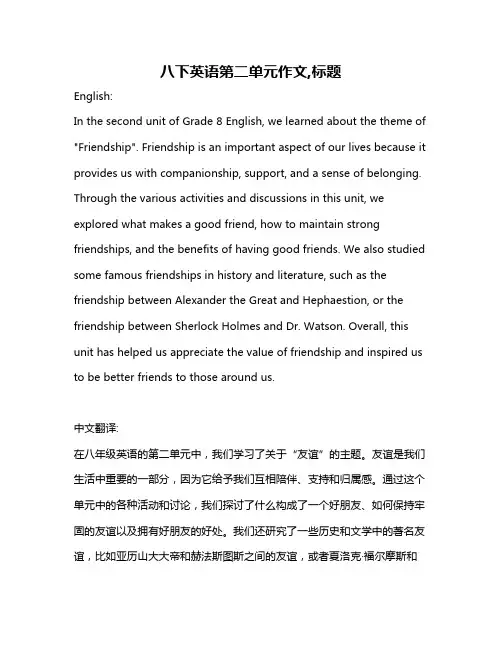
八下英语第二单元作文,标题English:In the second unit of Grade 8 English, we learned about the theme of "Friendship". Friendship is an important aspect of our lives because it provides us with companionship, support, and a sense of belonging. Through the various activities and discussions in this unit, we explored what makes a good friend, how to maintain strong friendships, and the benefits of having good friends. We also studied some famous friendships in history and literature, such as the friendship between Alexander the Great and Hephaestion, or the friendship between Sherlock Holmes and Dr. Watson. Overall, this unit has helped us appreciate the value of friendship and inspired us to be better friends to those around us.中文翻译:在八年级英语的第二单元中,我们学习了关于“友谊”的主题。
友谊是我们生活中重要的一部分,因为它给予我们互相陪伴、支持和归属感。
通过这个单元中的各种活动和讨论,我们探讨了什么构成了一个好朋友、如何保持牢固的友谊以及拥有好朋友的好处。
(完整版)新人教版八下英语全册优秀教案,推荐文档
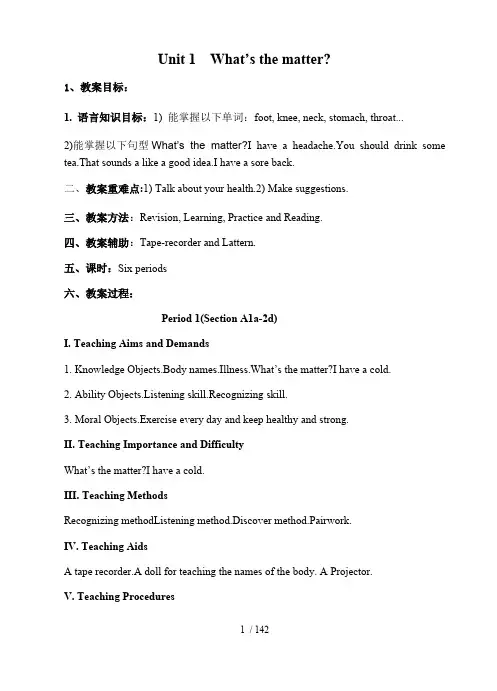
Unit 1 What’s the matter?1、教案目标:1. 语言知识目标:1) 能掌握以下单词:foot, knee, neck, stomach, throat...2)能掌握以下句型What’s the matter?I have a headache.You should drink some tea.That sounds a like a good idea.I have a sore back.二、教案重难点:1) Talk about your health.2) Make suggestions.三、教案方法:Revision, Learning, Practice and Reading.四、教案辅助:Tape-recorder and Lattern.五、课时:Six periods六、教案过程:Period 1(Section A1a-2d)I. Teaching Aims and Demands1. Knowledge Objects.Body names.Illness.What’s the matter?I have a cold.2. Ability Objects.Listening skill.Recognizing skill.3. Moral Objects.Exercise every day and keep healthy and strong.II. Teaching Importance and DifficultyWhat’s the matter?I have a cold.III. Teaching MethodsRecognizing methodListening method.Discover method.Pairwork.IV. Teaching AidsA tape recorder.A doll for teaching the names of the body. A Projector.V. Teaching ProceduresLead-in Name the parts of the body by pictures.Step 1Read a chant about the body.Step 2Enjoy a song.Step 3Play a game. Say and draw the part of body.Step 4Activity 1a.Let Ss to look at the picture and write the correct letter [a-m] for each part of the body.Step 5Judge their problems based on every picture.Step 6Activity 1b.Listen and look at the picture. Then number the names [1-5].Step 7Act it out with their partner.Step 8Listen again and complete the table.Step 9Activity 1c. Pair works.Make conversations according to pictures.Step 10Think how to give advice if somebody is ill and give examples by using pictures.Step 11Activity 2a.Let Ss to listen and number the pictures [1-5] in the order they hear them.Step 12Activity 2b.Listen again and match the problems with the advice.Step 13Activity 2c.Make conversations using the information in 2a and 2b.Step 14Activity 2d.Role-play the conversation.Step 15Language points: explain the key words and phrases in section A-1.Homework:Teaching thought:Period 2(Section A 3a-3c)I. Teaching Aims and Demands1. Knowledge Objects New words.Some advice.Grammar Focus.2. Ability ObjectsListening skill.Reading skill.Writing municative competence.3. Moral Object To be a doctor and serve the people heart and soul.II. Teaching Importance and DifficultyWhat’s the matter?I have a toothache.Maybe you should see a dentist.That’s a good idea.III. Teaching Methods Listening method.Reading and writing methods.Pair-work.IV. Teaching Aids A tape recorderA projector.V. Teaching ProceduresLead-in Review some usual disease by pictures.Step 1Talk about advice about health.Step 2Learn some new words.Step 3Discussion.Look at the title and the picture. Work in pairs and discuss some questions.Step 4Activity 3a.Read the passage. Discuss where it comes from.Step 5Give some reading strategies simply.Step 6Read the passage and do true or false.Step 7Activity 3b.Ask Ss to read the passage again and check (√) the things that happened in the story.Step 8Free talk.If you see someone lying on the street, what should you do?.Step 9Respect the aged and care for the young. It is a fine tradition of the Chinese nation. Teach the spirit to Ss.Step 10Activity 3c.Discuss the questions with a partner.Step 11Language points: explain the key words and phrases in section A-2.Step 12More exercises about the language points.Homework:Teaching thought:Period 3(Grammar Focus-4c)I. Teaching Aims and Demands1. Knowledge Objects Reading and writing materials.Oral Practice.2. Ability Objects Reading skill.Writhing municative competence.3. Moral Object Give good advice when someone needs your help.II. Teaching Importance and Difficulty Reading practice.Oral practice.III. Teaching Methods Reading and writing methods.Pair-work.Group-work.IV. Teaching Aids Workbook exercises.V. Teaching ProcedureLead-in Role - play a conversation between a patient and a doctor.Step 1List some health problems and give some advice.Step 2Explanation about the use of modal verb should.Step 3Do some basic exercise.Step 4Compare some other modal verbs.Step 5Do more exercise.Step 6Complete activity 4a and 4b.Step 7Work in groups. Discuss how to keep ourselves healthy.Step 8Complete activity 4c.Step 9Do exercise to review the structures of this unit.Homework Finish off the exercises of workbook.Teaching thought:Period 4(Section B 1a-1d)I. Teaching Aims and Demands1. Knowledge Objects Key vocabulary.Reading practice.Oral practice.2. Ability ObjectsListening skill.Reading skill.Writhing skill.Practice municative competence.3. Moral Object Ask for help when you have problem.II. Teaching Importance and DifficultyKey vocabulary.Reading practice.Oral practice.III. Teaching MethodsReading and writing methods.Understanding method.Pair-work.Listening method.IV. Teaching Aids A tape recorder.V. Teaching ProceduresLead-in Free talk:When these accidents happen, what should you do?Step 1Activity 1a.Put the actions in order.Step 2Activity 1b.Listen to the school nurse. Check (√) the problems you hear.Step 3Activity 1c.Listen again. Write the letter of each treatment next to the problemsyou checked in thechart above.Step 4Free talk:1. What would you do in these situations?2. What could we do to prevent these accidents?Step 5Give advice when accidents happen.Step 6Pair works.Let Ss make conversations.E.g.:A:Who came to your office today?B: First, a boy came in. He hurt himself in P.E. class.A: What happened?B: …Homework After class you can talk to an expert about a particular problem.For exaple, what should I do when I have problems with my little brother?Teaching thought:Period 5(Section B 2a-2e)I. Teaching Aims and Demands1. Knowledge Objects Key vocabulary.Reading material.Group work.2. Ability Objects Reading skill.Writhing municative competence.3. Moral Object Great Chinese culture.II. Teaching Importance and DifficultyKey vocabulary.Reading practice.Writing exercise.Group-work.III. Teaching Methods Reading and writing municative approach.IV. Teaching Aids A projector.V. Teaching ProceduresLead-in Learn some new words.Step 1Free talk:What is the most important in our life?Step 2Think about the question by giving pictures:What kind of accident or problem can happen when you …?Step 3Think about some accidents and talk about some advice to protect them.Step 4Activity 2a.Write the letter of each sport next to each accident or problem that can happen.Step 5Discuss these questions in groups.Step 6Activity 2b.Read the passage and underline the words you don’t know.Step 7Activity 2c.Read the statements and circle True, False or Don’t know.Step 8Activity 2d.Read the passage again and answer the questions.Step 9Activity 2e.Put the sentences in the correct order.Step 10Introduce the story of 127 Hours.Homework Write down the sentences about when you’re tired in your exercise book.Teaching thought:Period 6(Section B 3a-Self Check)I. Teaching Aims and Demands1. Knowledge Objects Vocabulary in this unit.Writing practice.Just for Fun.2. Ability Objects Reading skill.Writhing municative competence.3. Moral Object Give your help to who needs one.II. Teaching Importance and Difficulty Vocabulary in this unit.Writing practice.III. Teaching Methods Reading and writing methods.Self check method.IV. Teaching Aids A projector.V. Teaching ProceduresStep 1Enjoy a video: Between a Rock and a Hard Place.Step 2Talk about a story about a person who once were “between a rock and a hard place”.Step 3Activity 3a:Imagine you are the school nurse and a student just had an accident or a health problem. Make notes about what he/she should and shouldn’t do.Step 4Activity 3b:Write a conversation between the nurse and the student using the notes in 3a.Step 5Do self – check.Step 6Language points: explain the key words and phrases in section B-2.Step 7More exercisers about the language points.Homework Finish off the workbook exercises.Teaching thought:Unit 2 I’ll help to clean up the city park.一、教案目标:1. 语言知识目标:1) 能掌握以下单词:clean up, city, cheer, cheer up, give out, volunteer, notice,...2)能掌握以下句型:① You could help to clean up the city parks. ....3) 能了解以下语法:情态动词could, should的用法;用should或could提出建议并对别人的建议作出评价。
2023-2024人教版英语八年级下册大单元整体教学设计【新课标】Unit 4 Why don'
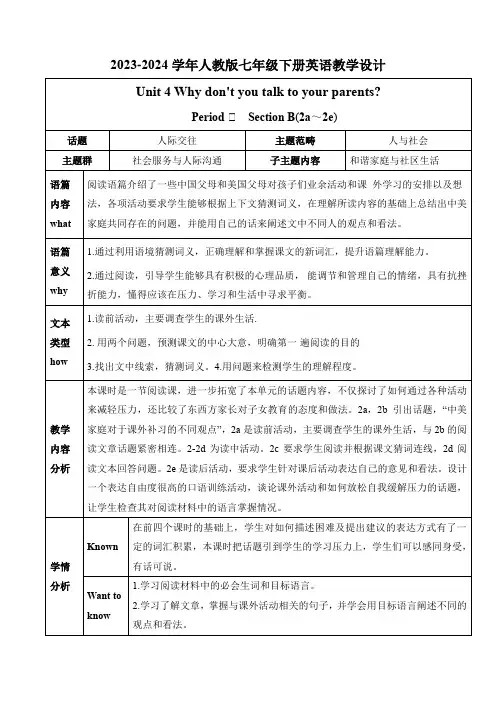
learned
1.通过阅读,了解中西方父母对待学生课外活的安排和想法。
2.学会用目标语言阐述不同的观点和看法。
3.通过文章的学习,学会换位思考,并感受中西方文化的不同。
核心
素养
教学
目标
语言
能力
1.掌握重点词/语opinion, skill, typical, compare… with等;
Key sentences:
Why don’t you …? /could /should
Opinion:
I believe…/I don’t think…
I agree or disagree /don’t agree …
Teaching Reflection:
在读前活动中,让学生通过标题对文章内容进行猜测,培养学生的预测阅读技能。在读中活动里,教师对各文段的内容逐段进行深挖,让学生通过安静细读找答案,培养其深度阅读习惯和高阶阅读思维品质的能力。比如,教师在设问时,有意识对每段设计2-3个问题,第一问为处理教材要求的低阶思维能力的训练,第二、三问就是教师对文本深挖后设置的高阶问题。在对各文段的内容了解的基础上丰富思维导图,培养学生对文段结构的了解及掌握能力。在对整篇文章的结构和内容都基本了解后,教师要求完成教材2c任务,培养学生根据上下文猜词并运用不同表述去表达同一意思的语言输出能力。本节课把阅读策略显性化,作为教学内容来呈现,使学生在教师的引领下,依托阅读文本,逐步、有序、自然地学习并运用这些阅读策略。同时,引导学生基于这些阅读策略,学习和积累相关语言知识,感悟文章内容,思考文章中给予的启示,获得情感共鸣。
Explain language points in this class.
初中英语_人教版八年级下册Unit5sectionA3a-3c教学设计学情分析教材分析课后反思
八年级下册unit5 SectionA3a-3b第二课时教学设计新目标六三制初中英语八年级下册Unit5sectionA3a-3b第二课时学情分析本学期我担任八年级英语教学工作,就近段时间对学生的了解来看,学生的总体水平不低,但也从教学中发现了不少问题。
现将学生的英语学习情况分析如下:八年级的学生性格特点是活泼好动,参与活动的热情会较高。
面对可塑性很强的学生,作为英语教师,我们一定要保护他们对英语学习的热情。
认知特点分析:学生已经学过过去进行时,本单元第一课时的学习也帮助学生对过去进行时有了初步的感知,学生理解上相对容易。
根据学生的心理特点我们一改以往教学生时的教学模式,课上多以表扬为主,注重对学生英语学习兴趣的培养,鼓励他们大胆说、积极做、努力尝试!让学生们在玩玩、做做、说说、谈谈中学习英语。
但这个年级的学生在学习方法和学习策略上还有待提高,尤其在答题技巧和技能方面还缺少锻炼。
因此本学期在实施英语教学的过程中,我和上学期一样在教授学生新知的同时更重视对学生学习方法和答题技巧的培养。
我一心争取在本学期让学生的学习能力和应试能力在原有的基础上能大幅度提高。
除以上所说的几种情况之外,八年级个别学生还存在顽劣和懒惰倾向,上课爱搞小动作、课下作业完成不及时的坏毛病,学习效率也较差。
针对这种情况我采取趣味教学的模式课上多为学生创设习得语言的环境,尽最大努力吸引学生的注意力以便更有交地激发他们的学习兴趣,而且课后老师经常找机会和他们聊天、交朋友,帮助他们转变厌学思想。
老师针对学生现状,在课堂上尽量以鼓励表扬为主,注重培养学习英语的兴趣,营造英语氛围,鼓励学生开口说英语、特别是给差生创造机会,让他们尝试成功的喜悦。
新目标六三制初中英语八年级下册Unit5 sectionA3a-3c第二课时效果分析通过free talking直接导入本节内容,直奔导入新课,简洁明了。
一.学生当堂对课文进行了多次阅读,并让学生仔细品读文章每一段落,总结概括大意并完成句子,锻炼学生的阅读能力,应用英语知识分析和解决英语问题的能力。
人教版初中英语八年级下册Unit8 大单元作业设计案例 (36)
人教版英语八年级下册Unit8作业设计一、单元信息二、单元分析(一)课标要求:本单元主要围绕“食物制作”这一话题展开,教材选篇为多模态语篇,包括对话,菜谱等连续性文本和图表,图示和图表等非连续性文本以及音频、视频等。
根据《义务教育英语课程标准(2011年版) 》(以下简称《课程标准》)要求,从语言技能、语言知识、情感态度、学习策略和文化意识等方面对本单元的课程内容进行分析。
1. 语言技能:能听懂关于食物制作的简单对话;听懂英文指令并能根据指示语做出相应的动作步骤。
能读懂菜谱;能正确使用表示序列的副词描述出制作食物的简单步骤。
2.语言知识:学习食物制作的动词及短语 (turn on,pour..into,cook for);食物名词(milk shake, ice-cream,yogurt,watermelon,honey,cabbage)以及表示制作顺序的副词(first,then,next, finally)。
能正确区分可数名词和不可数名词;能熟练运用How much/ How many 提问。
情感态度:积极参加综合运用英语的实践活动,在家能积极主动承担家务。
乐于了解他国文化,对家乡产生热爱之情。
学习策略:将语言学习与实践运用结合起来,学会认识菜谱并根据菜谱指示正确做出食物。
5. 文化意识:通过了解美国感恩节的习俗和美食加深对文化异同的理解,建构多元文化视角,培养社会责任感。
(二)教材分析:本教材版本为人民教育出版社2013年6月第一版新目标(Gofor it) 八年级上册英语。
本册书共包含10单元,每一单元都包含特定的话题,功能,结构,目标语言和相应词汇。
本单元是人教版新目标八年级上册第八单元 Unit8 How do you make a banana milk shake? 本单元的主题是如何制作食物。
通过学会正确使用单词及短语,再学会用序列词描述做一件事情的步骤。
使学生积极参与合作,从而培养学生的综合语言运用能力,教材在本单元的开篇设计的活动是制作香蕉奶昔。
新人教版七至九年级英语各单元标题
最新版(2013版)7-9年级各个单元标题七年级上册各单元标题预备篇Starter Unit 1 Good morning!Starter Unit 2 What’s this in English?Starter Unit 3 What color is it?Unit1My name’s Gina.Unit2 This is my sister.Unit3 Is this your pencil?Unit4 Where’s my schoolbag?Unit5 Do you have a soccer ball?Unit6 Do you like bananas?Unit7 How much are these socks?Unit8 When is your birthday?Unit9 My favorite subject is science.七年级下册各单元标题:Unit 1 Can you play the guitar?Unit 2 What time do you go to school?Unit 3 How do you go to school?Unit 4 Don't eat in class.Unit 5 Why do you like pandas?Unit 6 I’m watching TVUnit7 It’s raining!Unit 8 Is there a post office near here?Unit 9 What does he look like?Unit 10 I'd like some noodlesUnit 11 How was your school trip?Unit 12 What did you do last weekend?八年级上册各单元标题:Unit 1 Where did you go on vacation?Unit 2 How often do you exercise?Unit 3 I'm more outgoing than my sister.Unit 4 What's the best movie theater?Unit 5 Do you want to watch a game show?Unit 6 I'm going to study computer science.Unit 7 Will people have robots?Unit 8 How do you make a banana milk shake?Unit 9 Can you come to my party?Unit 10 If you go to the party, you'll have a great time!八年级下册各单元标题Unit 1 What's the matter?Unit 2 I’ll help clean up the city parksUnit 3 Could you please clean your room?Unit 4 Why don't you talk to your parents?Unit 5 What were you doing when the rainstorm came?Unit 6 An old man tried to move the mountains.Unit 7 What’s the highest mountain in the world?Unit 8 Have you read Treasure Island yet?Unit 9 Have you ever been to a museum?Unit 10 I've had this bike for three years.九年级全册个单元标题Unit1 How can we become good learners ?Unit 2 I think that mooncakes are delicious.Unit 3 Could you please tell me where the restrooms are ? Unit 4 I used to be afraid of the darkUnit 5 What are the shirts made of ?Unit 6 When was it invented ?Unit7 Teenagers should be allowed to choose their own clothes Unit 8 It must belong to CarlaUnit 9 I like music that I can dance toUnit 10 You are supposed to shake handsUnit11 Sad moives make me cry.Unit 12 Life is full of the expected.Unit 13 We’re trying to save the earth.Unit14 I remember meeting all of you in Grade 7.。
八年级下册第一单元作文标题
八年级下册第一单元作文标题In the first unit of the eighth grade second semester, we learned about the topic of friendship. Friendship is a crucial aspect of everyone's life, and it plays a significant role in shaping our personalities and experiences. It is essential to have friends who support us, challenge us, and bring out the best in us.在八年级下学期的第一个单元中,我们学习了有关友谊的主题。
友谊是每个人生活中至关重要的一部分,它在塑造我们的个性和经历中扮演着重要的角色。
有支持我们、挑战我们并让我们变得更好的朋友是至关重要的。
Friendship provides us with emotional support during difficult times and makes our lives richer with shared experiences and memories. True friends are there for us through thick and thin, celebrating our successes and comforting us during failures. They are the ones we can count on to lift our spirits and make us feel understood and accepted.友谊在困难时期为我们提供情感支持,并通过分享经历和回忆使我们的生活更丰富。
- 1、下载文档前请自行甄别文档内容的完整性,平台不提供额外的编辑、内容补充、找答案等附加服务。
- 2、"仅部分预览"的文档,不可在线预览部分如存在完整性等问题,可反馈申请退款(可完整预览的文档不适用该条件!)。
- 3、如文档侵犯您的权益,请联系客服反馈,我们会尽快为您处理(人工客服工作时间:9:00-18:30)。
新人教版八年级下册英语短语全册Unit 1 What’s the matter?一、重点短语1. have a fever 发烧2. have a cough 咳嗽3. have a toothache 牙疼4. talk too much 说得太多5. drink enough water 喝足够的水6. have a cold 受凉;感冒7. have a stomachache 胃疼8. have a sore back 背疼9. have a sore throat 喉咙痛10. lie down and rest 躺下来休息11. hot tea with honey 加蜂蜜的热茶12. see a dentist 看牙医13. get an X-ray 拍X 光片14. take one’s temperature 量体温15. put some medicine on sth. 在……上面敷药16. feel very hot 感到很热17. sound like 听起来像18. all weekend 整个周末19. in the same way 以同样的方式20. go to a doctor 看医生21. go along 沿着……走22. on the side of the road 在马路边23. shout for help 大声呼救24. without thinking twice 没有多想25. get off 下车26. have a heart problem 有心脏病27. to one’s surprise 使....... [京讶的28. thanks to 多亏了;由于29. in time 及时30. save a life 挽救生命31. get into trouble 造成麻烦32. right away 立刻;马上33. because of 由于34. get out of 离开;从……出萍35. hurt oneself 受伤36. put a bandage on sth. 用绷带包扎37. fall down 摔倒38. feel sick 感到恶心39. have a nosebleed 流鼻血40. cut his knee 割伤他的膝盖41. put her head back 把她的头向后仰42. have problems breathing 呼吸困难43. mountain climbing 登山运动44. be used to doing sth. 习惯做某事45. run out (of) 用完;用尽46. so that 以便47. so. . . that 如此……以至于…48. be in control of 掌管;管理49. in a difficult situation 在闲境屮50. keep on doing sth. 继续或坚持做某事51. make a decision 做出决定52. take risks 冒险53. give up 放弃二、重点句型1. What’ s the matter?What’ s the matter with you?= What’s the trouble with you? = What’ s wrong with you?你怎么了?2. What should she do?她该怎么办呢?Should I take my temperature? 我应该量一下体温吗?主语+ should/shouldn’t + 动词原形. ..①You should lie down and rest. 你应该躺下休息一会儿。
②You shouldn’t go out at night.你晚上不应该出去。
3. Do you think it comes from a newspaper or a book?你认为它是来自报纸还是书呢?4. I think I sat in the same way for too long without moving.我想我以同样的姿势一动不动地坐得太久了。
5. She said that the man had a heart problem and should go to the hospitalUnit 2 I’ll help to clean up the city parks.一、重点短语1. Clean-Up Day 清洁日2. an old people’s home 养老院3. help out with sth. 帮助解决困难4. used to 曾经…过去_5. care for 关心;照顾6. the look of joy 快乐的表情7. at the age of 在......岁时8.clean up 打扫(或清除)干净9. cheer up (使)变得更高兴;振雀10. give out 分发;散发11. come up with 想出;提出12. make a plan 制订计划13. make some notices 做些公告牌14. try out 试用;试行15. work for 为…工作;为…. 效力16. put up 建造;举起;张贴17. hand out 分发;散发;发给18. call up 打电话;召集19. put off 推迟;延迟20. for example 比如;例如21. raise money 筹钱;募捐22. take after 与......相像;像23. give away 赠送;捐赠24. fix up 修理;修补;解决25. be similar to 与……相似26. set up 建立;设立27. disabled people 残疾人28. make a difference 影响;有作用29. be able to 能够30. after-school reading program课外阅读项目二、重点句型1. The boy could give out food at the food bank.这个男孩可以在食品救济站分发食物。
2. Clean-Up Day is only two weeks from now.清洁日离现在仅仅两周的时间。
3. He volunteers at an animal hospital every Saturday morning.每周六上午,他都在一'家动物医院当志愿者。
4. Last year, she decided to try out for a volunteerafter-school reading program.去年,她决定去参加一个课外阅读项目的志愿者的选拔。
5. . . . you can see in their eyes that they’ re going ona different journey with each new book.……从他们的眼睛里你可以看到他们正在进行每本不同的新书之旅。
6. I want to put off my plan to work in an animal hospital until next summer.我想把我在动物医院工作的计划推迟到明年夏天。
7. Most people today are only worried about getting good jobsto make lots of money.现在的大部分人只是为找一份能挣许多钱的好工作而着急。
8. You helped to make it possible for me to have Lucky. 在你的帮助下,我才有可能拥有“幸运儿”。
Unit 3 Could you please clean your room?一、重点短语1. go out for dinner 出去吃饭2. stay out late 在外面待到很晚3. go to the movies 去看电影4. get a ride 搭车5. work on 从事6. finish doing sth. 完成做某事7. clean and tid y 干净整洁8. do the dishes 洗餐具9. take out the rubbish 倒垃圾10. fold your/the clothes 叠衣服11. sweep the floor 扫地12. make your/the bed 整理床铺13. clean the living room 打扫客厅14. no problem 没问题15. welcome sb. 欢迎某人16. come home fro m school/ work放学/下班回家17. throw down 扔下18. sit down 坐下19. come over 过来20. take sb. for a walk 带某人去散步21. all the time 一直;总是22. all day/evening 整曰/夜23. do housework 做家务24. shout back 大声回应25. walk away 走开26. .share the housework 分担家务27. a comfortable home 一个舒适的家28. in surprise 惊讶地29. get something to drink 拿点喝的东西30. watch one show 观看一个节目31. hang out 闲逛32. pass sb. sth. 把某物传给某人33. lend sb. sth. 把某物借给某人34. get sth. wet 使某物弄湿35. hate to do sth. 讨厌做某事36. do chores 做杂务37.help sb. (to ) do /with sth帮助某人干某事38. bring a tent带顶帐篷来39. buy some snacks买些小吃40. go to the store去商店41. invite sb. to a party邀请某人参加聚会42. make sb. do sth. 使某人做某事43. enough stress足够的压力44. a waste of time浪费时间45. in order to为了46. get good grades取得好成绩47. mind doing sth. 介意做某事48. depend on依赖;依靠49. develop children’s independence发展孩子的独立性50. look after/take care of 照顾;照看51. do one’ s part in (doing ) sth.做某人分内的事二、重点句型1. Could you please…..do sth. ? Could you please clean yourroom?你能整理一下你的房间吗?2. I have to do some work.我必须干些活。
